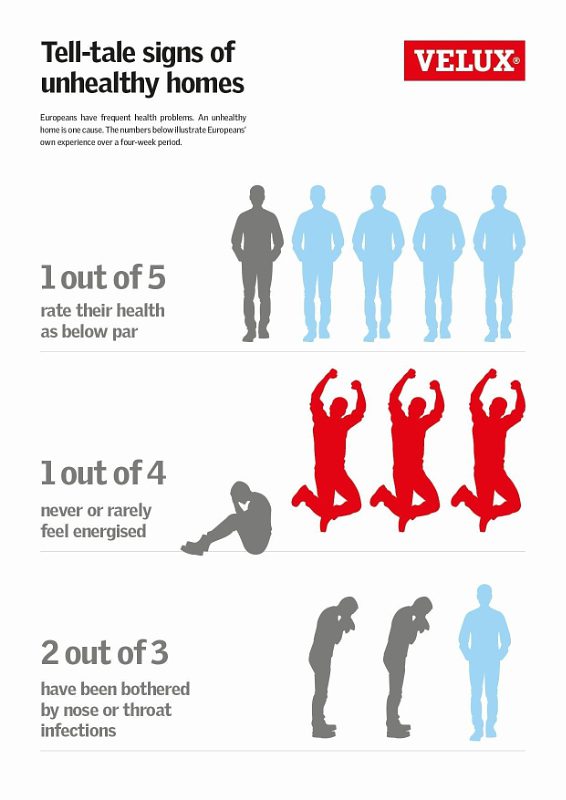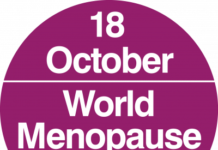Europeans who live in unhealthy homes experience worse overall health, as well as suffering flu–like symptoms and fatigue more often, a new study from VELUX and Humboldt University finds. The study points to five characteristicsof unhealthy homes, suggesting that the building industry and political decision–makers must work together to improve well-being and prevent loss ofeconomic productivity.
Large numbers of Europeans suffer from health problems and lack of well-being every single day. This is bad for quality of life and is also a likely cause of significant loss of productivity in the economy. A new study conducted by the VELUX Group in collaboration with Humboldt University, Germany, points to five indications that unhealthy homes are part of the problem. The potential costs to society are billions of Euros – in sick days and lower quality of life.
The Healthy Homes Barometer study surveyed 14,000 people across 14 European countries in order to achieve a better understanding of how Europeans’ homes affect their health.
Michael K. Rasmussen, Chief Marketing Officer of the VELUX Group:
“The homes we live in are important for our health and well-being and mustoffer good sleeping conditions, good indoor climate and plenty of daylight. The results of this study should be noted both in the building industry and among political decision-makers, and should help set the direction for the renovation of existing building stock in Europe and for new buildings.“
How to diagnose an unhealthy home
The study points to five characteristics of European homes that determine whether our homes are healthy or unhealthy. They are: good sleeping conditions; comfortable indoor temperatures; sufficient amounts of daylight; fresh air; and healthy levels of humidity.
The evidence is clear. Europeans who live in cold houses or have mould in their home are approximately 50% more likely to suffer from illnesses like nose or throat infections. Meanwhile, if the home allows for a good night’s sleep, Europeans are 50% more likely to feel they have good health and feel energized. Having enough daylight in the home almost halves the risk of being low on energy, while people who never air out their homes are twice as likely to suffer from low energy levels compared to Europeans who do so two-to-four times daily.
These characteristics are related to both home construction and habits of everyday use.

Health and home satisfaction go hand in hand
Healthy homes are good not only for our bodies, but they also lift our sense of home satisfaction. For example, good sleep quality, lots of fresh air, plenty of daylight and appropriate levels of humidity are all amongst the top contributors to home satisfaction. Good indoor climate even trumps the expense of energy costs when looking at what creates most home satisfaction.
“The fact that what makes a healthy home also is what makes us happy with our home is a huge boost to the public debate about sustainable building. I think we need to move towards seeing the sustainable home in a wider perspective, not only focusing on how to save energy, but also how to secure good health and a high quality of life“, says Michael K. Rasmussen.
Raising quality of life – saving society billions
The potential for lifting European health and quality of life are huge. In the study, one in four feel their health is below par, one in four never feel energized and half of all Europeans suffer from sore throats and runny noses.
Data from the UK Office of National Statistics show that 27 million working days were lost in 2013 in the UK alone due to minor illnesses like coughs, colds or flu. Preventing these could save society billions and increase productivity.
“The results in the study point towards a common interest between governments, the building industry and private home owners. We need to work together to make this change happen“, concludes Mr Rasmussen.
The results of the study will be presented at the 2nd Healthy Buildings Day conference on April 20th in Brussels, Belgium.
The consequences of unhealthy homes in Europe
- Europeans who live in cold houses are approximately 50% more likely to suffer from nose and throat infections
78% of Europeans live in houses that were too cold at some point during the last winter. 15% report this to be the case all or most of the time.
- Europeans whose home allows for a good night‘s sleep are 50%more likely to feel they have good health and are energized
71% of Europeans do not have optimal sleeping conditions in their home. One in three report their sleep quality within the last four weeks as either very bad or fairly bad
- Europeans who never air out their homes are twice as likely to suffer from low energy levels compared to Europeans who air out 2-4 times daily
59% of Europeans do not air out at least twice a day.
- Having enough daylight in the home almost halves the risk of being low on energy
40% of Europeans who lack daylight in their living room never or very seldom feel energized. If daylight levels are appropriate, the share drops to 23%.
- Europeans who have mould in their home are 50% more likely to suffer dryness or irritation of the throat
Among Europeans with mould in their home, up to 60% experience dryness or irritation of the throat. For Europeans who do not have this problem the share is 40%.
Download the Healthy Homes Barometer 2016 at http://emagcreator.com/VELUX/HHB_2016/
Help keep news FREE for our readers
Supporting your local community newspaper/online news outlet is crucial now more than ever. If you believe in independent journalism, then consider making a valuable contribution by making a one-time or monthly donation. We operate in rural areas where providing unbiased news can be challenging. Read More About Supporting The West Wales Chronicle























